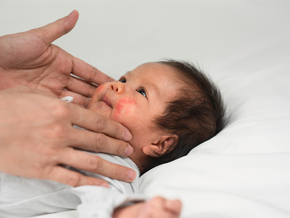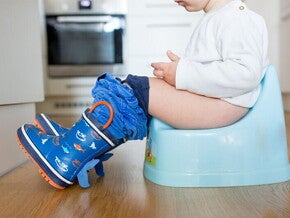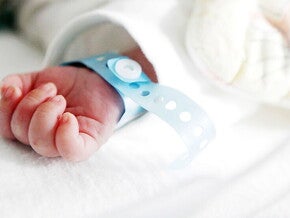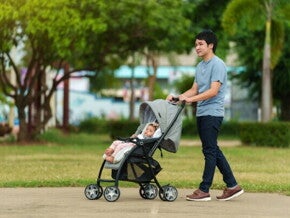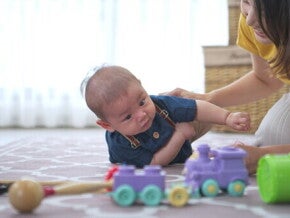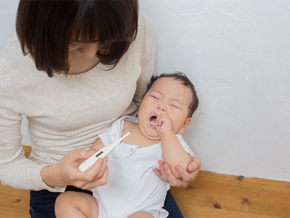
Baby Constipation Isn’t Just Fewer Poop Days: Here's What Else Matters
Regular bowel movement has always been a sign of good health. So, when baby constipation arrives at your door, who can blame you for singing "poo-poo" or making funny sounds to coax your baby to poop?
It's hard not to worry when you think your baby might have tummy troubles. But, once you figure out the cause and learn the signs, you can take the proper steps to prevent constipation from happening again. Here's a guide to help you and your baby feel good when it's pooping time! (Check out this guide on constipation relief for kids 4 years old and up.)
Causes of Constipation in Babies
Baby constipation can happen for many reasons. However, the leading cause is often related to diet, especially when your little one begins eating solids. Diet-related causes of constipation may include:
- Introduction to solid foods, a transition that a baby's digestive system may find difficult to process
- Switching from breast milk to formula since the latter may be harder to digest
- Eating processed foods or drinking cow's milk, especially if the baby is not ready for these dietary changes
- Not drinking enough fluids, whether breast milk, formula, or water (for babies old enough for water)
- Lack of fiber-rich foods for babies who have started on solids
Remember that when babies become sick, such as with vomiting, fever, or infections, they can lose a significant amount of fluid. This loss can lead to dehydration, which can cause constipation.
Signs of Baby Constipation
Just because your baby hasn't pooped in a few days doesn't automatically mean they're constipated. You also have to look at the quality of their stool (this baby poop guide discusses healthy colors).
Baby constipation is likely if their poop looks or feels like any of the following:
- Small and hard, like pellets
- Separate hard lumps like nuts
- Sausage-shaped because lumps are stuck together
- Stool the size of a large golf ball
In addition to stool quality, your little one may show the other signs of constipation, such as:
- Blood in the stool
- Being fussier than usual or having sleep difficulty
- Gassiness, bloating, or belly discomfort
Grimacing and redness of the face due to straining aren't always a cause of concern especially for newborns. They're figuring out how to work the muscles to push poop out while keeping the anus relaxed.
However, if you see two or more signs of constipation in your baby, see your child's pediatrician at once.
How to Relieve Constipation in Babies

Move your baby's legs like a bicycle pedal to help things get moving in their tummy.
Before starting any home remedy, always consult your child's pediatrician. You may have come across something like a "constipation diet," and doctors will tell you there's no such thing for children. However, if the cause of baby constipation is due to diet, these may help keep things moving and make bowel movements more comfortable.
1. Make sure your baby is well-hydrated.
Talk to your doctor how best to boost your baby's fluid intake. Only offer water or any other fluid to a baby less than 6 months old when advised by a pediatrician.
2. Move your baby's legs.
During diaper changes, hold your baby's legs and move them in a gentle cycling motion. You can also give them more tummy time to get their bowels moving. These options may work better if your baby doesn't like massages or their cord has not healed.
3. Give your baby a warm bath.
Let your baby soak in warm (not hot) water for about 10–15 minutes. You can gently massage their tummy in a clockwise motion while they’re in the bath for added benefit.
4. Gently massage your baby's tummy.
Using gentle pressure, massage your little one's abdomen in a circular, clockwise motion. You can try the "I Love U" technique below. Before starting, apply baby-safe oil or lotion to warm your hands.
- Lay your baby on the back with their tummy exposed.
- Starting at the base of your baby's rib cage, gently stroke downwards with one hand (palm flat) and then the other in a paddle-like motion.
- Trace the letter "I" down your baby's left side (or your right as you face them).
- Then, trace an inverted "L," stroking across the belly along the base of their ribs from their right side to their left and down.
- Form an upside-down "U" by stroking from low on the baby's right side, up and around the navel, and down the left side again.
- Then, walk your fingers around the navel clockwise.
- Hold the knees and feet together and gently press the knees up toward the abdomen. Rotate the baby's hips around a few times to the right.
- Place your hand on the tummy horizontally and rock your hand from side to side a few times.
Repeat the sequence a few times, always moving in a clockwise direction, which follows the path of the intestines. If your baby's cord has not completely healed, avoid massaging the tummy. You should also watch your baby’s cues. If they seem uncomfortable, stop any baby massage for constipation and try again later.
FAQs About Baby Constipation
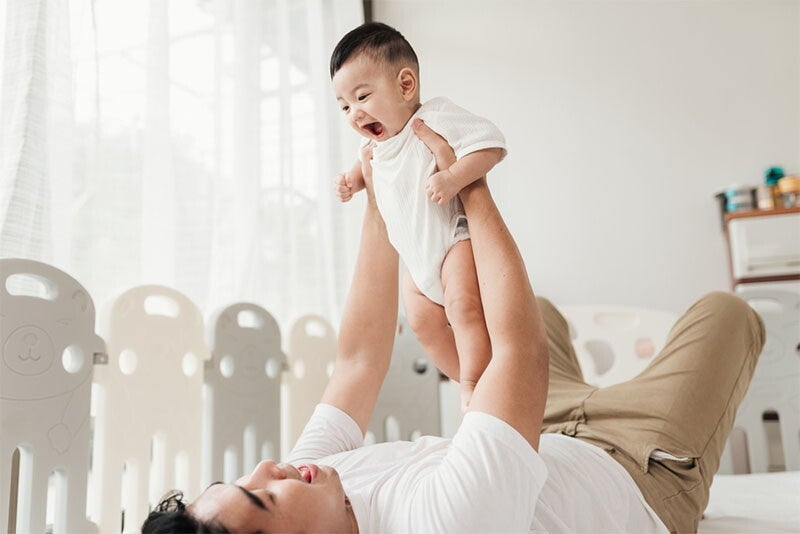
Talk to your doctor when it comes to fluid intake to prevent baby constipation.
Always remember your baby's situation is not the same as someone else's little. Always check in with your child’s pediatrician or family doctor for advice. Here are answers to other questions you may have about constipation.
When should I go to my child's pediatrician?
Contact your child's provider right away if you see these red flags, which indicate an underlying disease is causing the constipation.
- Meconium has not passed in first 48 hours for newborns
- Family history of Hirschsprung disease
- Blood in the stools with fever
- Failure to thrive (chronically low weight for height)
- Abnormal lower extremity neurologic exam
- Abnormal reflexes
- Paresthesia (numbness or tingling feeling)
- Weakness
- Sacral dimple or tuft of hair on spine
- Perianal fistula or scars
Is it normal for babies to go several days without pooping?
Every child is different, including their bowel patterns. And if your baby is exclusively breastfed, they may go for several days without any bowel movements. In her ParenTeam article, Dr. Katrina Anne Valera writes infrequent bowel movement isn't always a sign of constipation as long as your baby's poops are soft.
What causes constipation in breastfed infants?
Constipation is less common in breastfed babies since breast milk is easily absorbed. Check with your child's pediatrician to rule out any medical issues related to digestion or metabolism.
Can I use over-the-counter laxatives for my constipated baby?
You should only use laxatives when prescribed by a doctor. This applies to any other medication or "home syrups" you may have seen on social media or online.
Can probiotics cause constipation in infants?
Research on probiotic use doesn't answer the question of whether probiotics make babies constipated. These studies actually suggest that probiotics (and prebiotics) may improve stool quantity and quality. However, you should only use probiotic supplements when doctors prescribe it.
Most of the time, constipation is temporary as your little one adjusts to new foods and routines. It's also manageable with simple dietary changes. Trust your instincts, keep an eye on the signs, and don’t hesitate to check in with your pediatrician if something doesn’t feel right.
Join the ParenTeam Moms and Dads Facebook group, where the topic of baby constipation is never TMI!
References
Allen, Paul, Aniruddh Setya, and Veronica N. Lawrence. “Pediatric Functional Constipation.” StatPearls - NCBI Bookshelf, January 11, 2024. Accessed June 25, 2025. https://www.ncbi.nlm.nih.gov/books/NBK537037/.
Matt Barber, “Breastfed Babies and Constipation - ERIC,” ERIC, January 23, 2024, accessed June 25, 2025, https://eric.org.uk/breastfed-babies-and-constipation/.
Nationwide Children’s Hospital. “Constipation in Infants.” Accessed June 25, 2025. https://www.nationwidechildrens.org/conditions/constipation-infant
“Constipation in Infants and Children: MedlinePlus Medical Encyclopedia.” Accessed June 25, 2025. https://medlineplus.gov/ency/article/003125.htm.
Ho, Jmd, and Ch How. “Chronic Constipation in Infants and Children.” Singapore Medical Journal 61, no. 2 (February 1, 2020): 63–68. https://doi.org/10.11622/smedj.2020014.
HealthyChildren.org. “How Can I Tell if My Baby Is Constipated?” Accessed June 25, 2025. https://www.healthychildren.org/English/ages-stages/baby/diapers-clothing/Pages/Infant-Constipation.aspx.
Mulhem, Elie, Faiza Khondoker, and Sanjiv Kandiah. “Constipation in Children and Adolescents: Evaluation and Treatment.” AAFP, May 15, 2022. Accessed June 25, 2025. https://www.aafp.org/pubs/afp/issues/2022/0500/p469.html.











